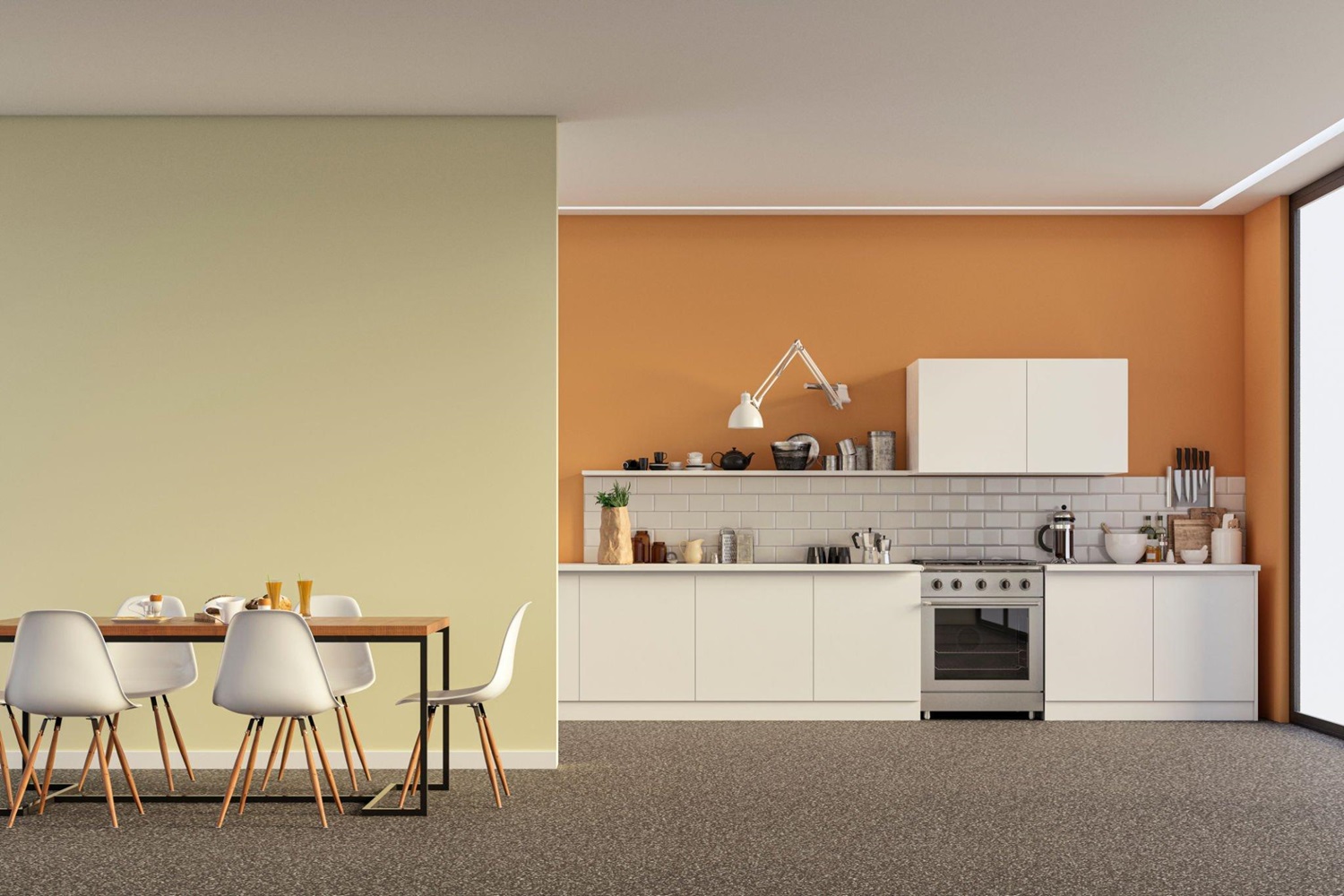
6 ways to combine wallpaper in the kitchen
Choosing for themselves a way of decorating the walls in the kitchen, many choose wallpaper. This is facilitated by a wide range of coatings, decent performance characteristics, as well as incredible opportunities to implement your own ideas and ideas.
Look at the examples given, how stylish, spectacular and non-trivial the combined wallpaper looks in the kitchen interior.
By choosing the right materials, you will be able to make adjustments to the configuration of the room, “pushing” the walls or “understanding” the ceilings, carry out competent zoning, emphasize the individuality of the design.
Accent wall
It is designed to attract looks, that is, it is better to make it bright and unusual. These can be coatings with large flowers, photo wallpapers, geometric drawings, etc. It is important not to overdo it with paints, otherwise the interior will be oversaturated and lose its uniqueness.
Bright wallpaper or wallpaper with a pattern are selected for it. The rest of the walls serve as a background, so it’s better to choose plain wallpaper for them.
Vertical combination
It is optimal for narrow and long rooms. It also allows you to make the ceilings visually higher.
When coming up with a design of combined wallpaper for the kitchen, pay attention to the above photos. On them you will see one of the most common finishing methods – a vertical combination.
Vertical stripes. You can create a unique play of light and color by pasting the walls alternately with strips of different wallpaper. You can combine both contrasting colors and shades of the same color, creating gradation.
You can choose wallpaper of the same shade, but with a different texture — for example, alternate matte and glossy.
An interesting option: alternating wallpaper with a pattern and plain. Stripes imitating real paintings are obtained. This technique is appropriate in a spacious kitchen.
In the photo, a harmonious combination in the English style – vertical stripes at the bottom create an imitation of wall panels, a classic floral pattern on top. The joint between the two types of wallpaper is decorated with a decorative border.
Striped wallpaper is most often used. They can be located:
- Symmetrical. In this case, the walls are pasted with wide strips mirrored from the center. Contrasting colors attract glances, so few people pay attention to the disproportion of the configuration of the room.
- Asymmetric. Canvases with wide stripes are pasted over only one wall, while canvases with a similar pattern, but of different widths, are applied to other surfaces. This makes the room look wider.
Correctly selected colors will also help to place accents in the room. Too bright shades should be alternated with pastel 1-1 or 1-2. It all depends on the size of the room and the desired effect
Horizontal Companion Wallpaper
It is used in rooms with high ceilings, fits perfectly into any interior directions. Designers use such a move in order to transform an excessively high room.
The photo shows a combined wallpaper with a horizontal stripe and a floral pattern.
Horizontally, you can combine wallpapers of different textures and shades. Choose options that are in harmony with each other and with the overall design of the kitchen.
To calculate the height of each strip, visually divide the wall into three horizontal parts. The narrowest strip should be located at the bottom.
One of the most popular solutions is the use of wooden or cork panels in the lower part. The top can be covered with coatings with a geometric pattern, large flowers or just bright monochrome canvases.
If the lower part stands out with a bright and large ornament, then it is better to choose a plain top.
Striped wallpaper can also be used as panels, separated from the upper part by means of a border or molding. At the top, it is better to use canvases with a small pattern or monochrome.
You can vary either colors or texture. It is worth choosing an option that will complement the overall design of your room, presenting it in the most favorable light.
Pechwork
Pechwork is an original technique of combining, which is appropriate in the style of country, Provence or ethno. Wallpaper with different patterns is cut into equal patches and pasted over the wall, alternating blocks.
Drawings and the number of color solutions should be no more than 3-4. It is also not uncommon to find a ready-made drawing on wallpaper in the pechwork style.
In the photo, bright wallpaper in the pechwork style. They give the interior a cozy and homely feeling.
In the process of selecting raw materials, you should be guided by the compatibility of colors, compliance with a given style and common sense. In this way, you can arrange a fragment of the surface or one wall from floor to ceiling. It all depends on the courage of your idea.
It is worth looking at this option for those who gravitate to a variety of textures and color shades, but cannot find a suitable solution for themselves.
The work will be quite difficult, since initially it is necessary to choose the optimal combinations, and only then create a spectacular picture from scattered pieces.
Patchwork attracts creative people who dream of transforming their home and are able to realize such painstaking work on their own.
Photo wallpapers and 3D
Photo wallpapers immediately become bright accents. Therefore, for the rest of the walls it is better to choose plain wallpaper, soft tones.
3D images that create the effect of presence and volume have also become one of the popular varieties of modernity.
A beautiful urban landscape creates an accent and gives a sense of volume to the room.
The choice of options is incredibly wide, ranging from classic food and drink themes (fruits, coffee and coffee beans, chocolate) to three-dimensional abstraction.
Such a picture should be as open to view as possible, so it is better to apply it to the most open surface. In most cases, the only one is the wall in the dining table area.
They can be created on any basis: non-woven, synthetic fabrics, vinyl. High-quality paints make them bright and resistant to fading even in direct sunlight.
They also have environmental friendliness, fire resistance, wear resistance, and ease of care. To wash them, you can use any household chemicals. But still the most significant and impressive advantage is the incredible aesthetics. In addition, absolutely any image can be transferred to the canvas.
Combination with other types of finishes
The combination of wallpaper and other finishing materials looks much more interesting: tiles, bricks, concrete, painting, wooden panels, cork, decorative plaster, mosaics.
There are hundreds of options, but there are a few general rules.
- The same thickness. The thickness of the coatings should be approximately the same, which will eliminate problems with docking.
- Do not use expensive and budget analogues at the same time. Give preference to materials from the same price category that differ in texture and color.
- The same shine. For example, a matte tile looks bad against a background of shiny, glossy wallpaper. It is desirable that the degree of gloss is as identical as possible.
- In combination with any, even the most expensive wallpaper, other finishing material still becomes accent. Therefore, it is better to bet on neutral colors for wallpaper.
- Adhere to the zoning principles. Chaotic inserts of other finishing material around the perimeter of the entire kitchen will bring disharmony. Complement large prints with wallpaper with a small pattern or monochrome, and saturated colors – pastel.
You will find more original ideas for using combined wallpapers for the kitchen in the interior in the photos below.
Everyone can find individual solutions for themselves, striking with sophistication and exclusivity.
Choosing the wallpaper material
Today there are quite a lot of varieties of wallpaper, but not all of them are suitable for the design of such a specific room.
Decide for yourself:
- Paper ones. They are inexpensive, environmentally friendly, air-permeable, but at the same time they are short-lived. If you decide to use them in the interior, then only away from the work area.
- Fabric. They are made on the basis of silk, linen, cotton. They can only be pasted on a perfectly smooth and smooth surface, otherwise all defects will be noticed. They will not withstand high humidity, and dirt is removed from them with great difficulty. Not the best option for the kitchen.
- Natural. They are made of dried grass, bamboo, wood shavings. All this is fixed on a special fabric base with glue or thin strong threads. They are endowed with environmental friendliness, but they absorb any odors extremely strongly.
- Non-woven. They are made of viscose, cellulose, polyester and acrylic. They differ in elasticity, resistance to moisture and fire, hide irregularities. There are special modifications for painting, allowing you to change the color up to 7 times.
- Vinyl. A polymer coating is applied to a non-woven base or technical paper, resistant to moisture and shrinkage, easy to care for (washable), elastic. Modern canvases have micropores through which air passes. Thanks to this, neither fungus nor mold ever appears on them.
- Glass walls. These are coatings for painting, creating an original relief texture on the surface. Water resistance, fire resistance, vapor permeability, wear resistance, stylish appearance are the most significant advantages of this option. The only disadvantage is that they are dismantled with great difficulty.
- Liquid. They include fibers and threads of acetate silk, cotton, viscose, cellulose, connected by means of an adhesive mixture. They are applied like a regular putty, leaving no seams, leveling defects. They are endowed with low heat and sound conductivity, are easy to clean, and differ in a wide range of tones.
All these types of wallpapers have their pros and cons. When making a choice, you should pay attention to performance, aesthetics and cost.
The combination of wallpapers is a whole science. We hope that our tips will help you decide on the design of the walls, choose the right wallpaper for your kitchen and combine them successfully. Share your thoughts, thoughts and ideas in the comments!
In conclusion, incorporating wallpaper into your kitchen renovation project can significantly enhance the aesthetic appeal and character of the space. Working with a professional remodeling company ensures that the wallpaper selection not only matches your personal style but also complements the kitchen’s functionality and overall design. Whether you opt for bold patterns, subtle textures, or vibrant colors, the right wallpaper can transform your kitchen into a more inviting and stylish area, adding a unique touch to your home. Remember, a successful kitchen remodel balances practicality with creativity, making wallpaper an excellent choice for those looking to make a statement in their culinary space.



